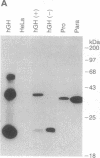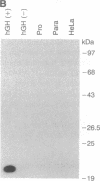Abstract
To test the hypothesis that prothymosin and parathymosin contain amino acid sequences that cause them to be targeted to the cell nucleus, expression vectors were constructed containing a simian virus 40 promoter and cDNAs that would code for chimeric proteins composed of truncated human growth hormone (hGH) linked to the NH2 terminus of prothymosin or parathymosin. The truncated hGH lacked the signal peptide sequence required for its secretion. After transfection of these constructs into HeLa S3 cells, which do not normally synthesize hGH, the use of indirect immunofluorescence staining to follow the localization of the hGH chimeras demonstrated that both prothymosin and parathymosin caused targeting to the cell nucleus. Controls with a construct coding for native hGH only, and one coding for the truncated hGH lacking the signal peptide, revealed secretion into culture medium and staining in the endoplasmic reticulum and Golgi apparatus in the first case, and diffuse staining throughout the cytoplasm in the second. The results provide direct evidence, with proteins synthesized in situ, for the presence of nuclear localization signals in both prothymosin and parathymosin.
Full text
PDF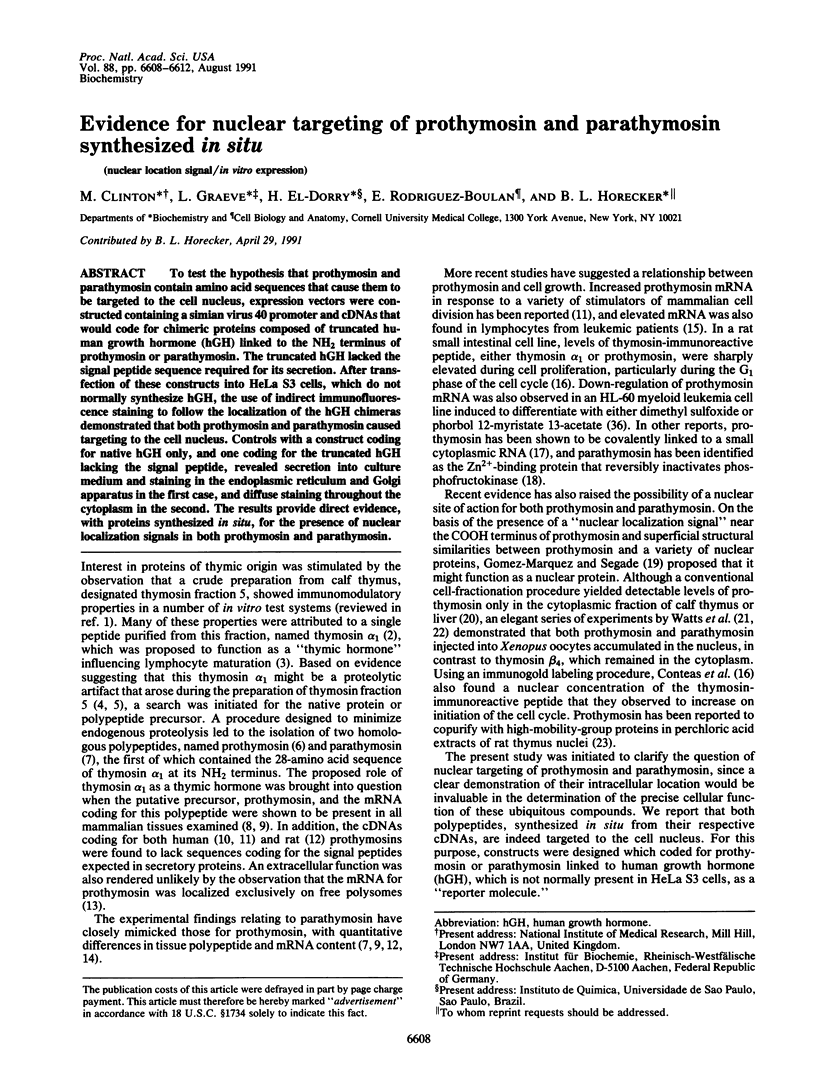
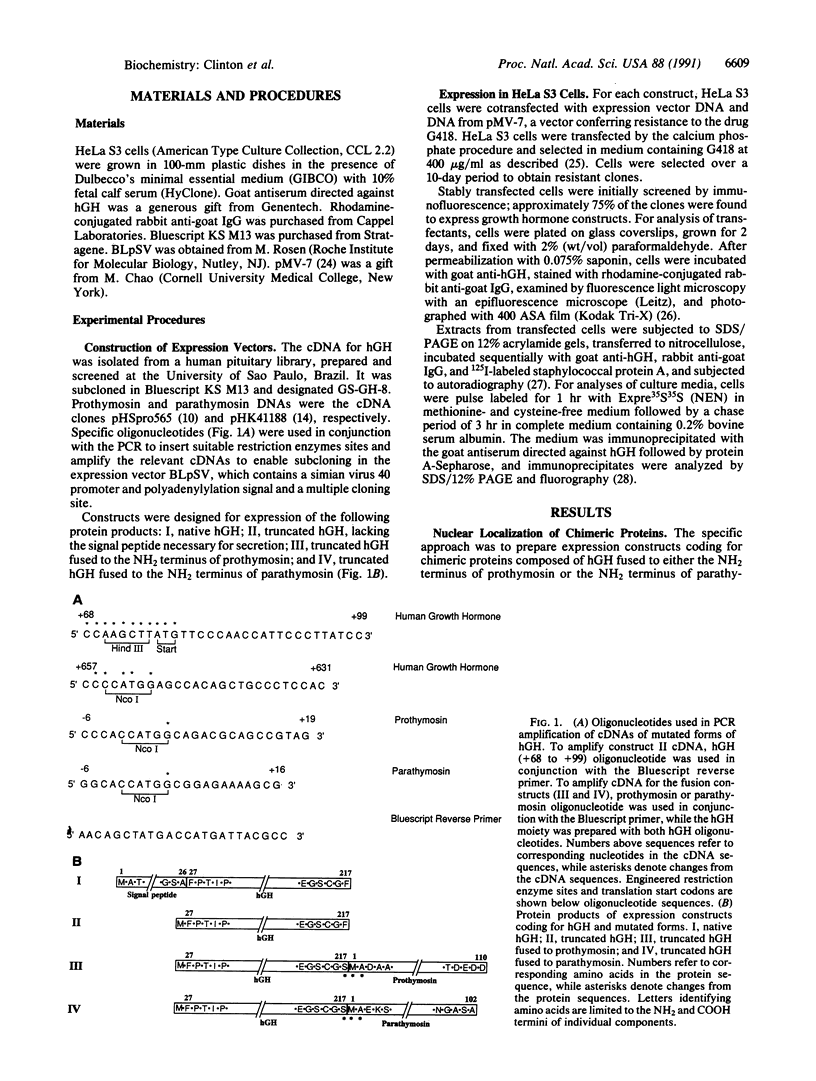
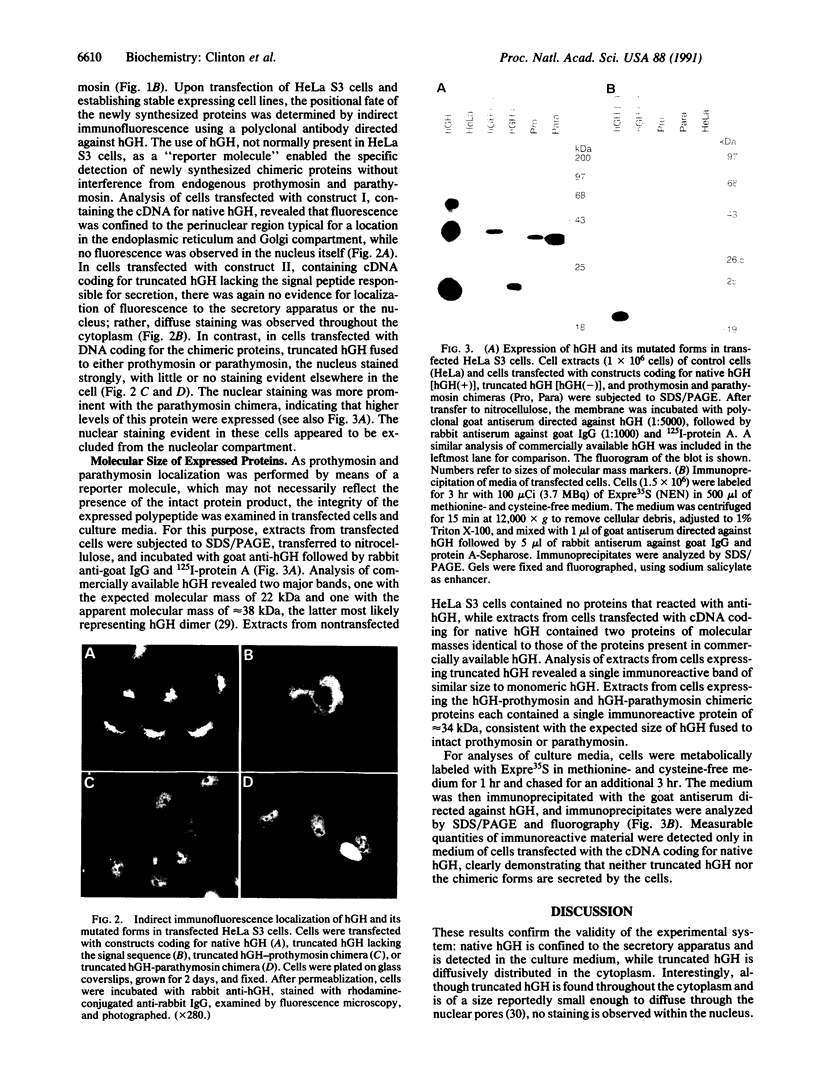
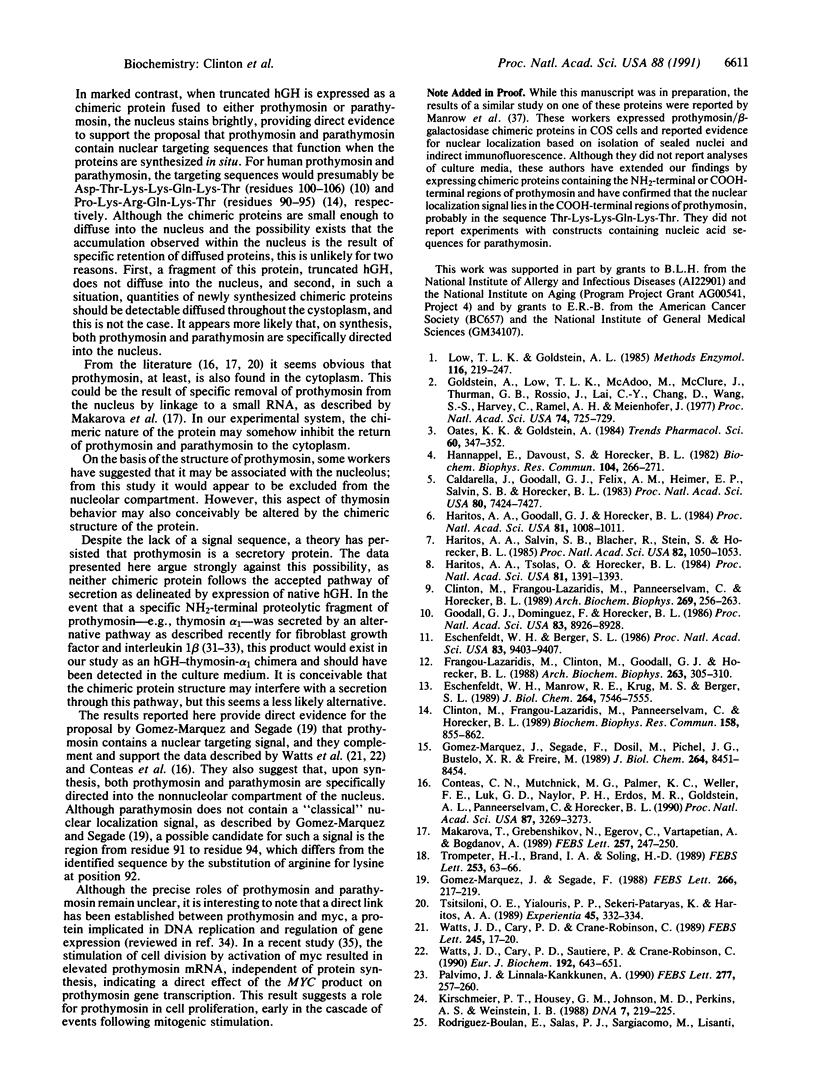
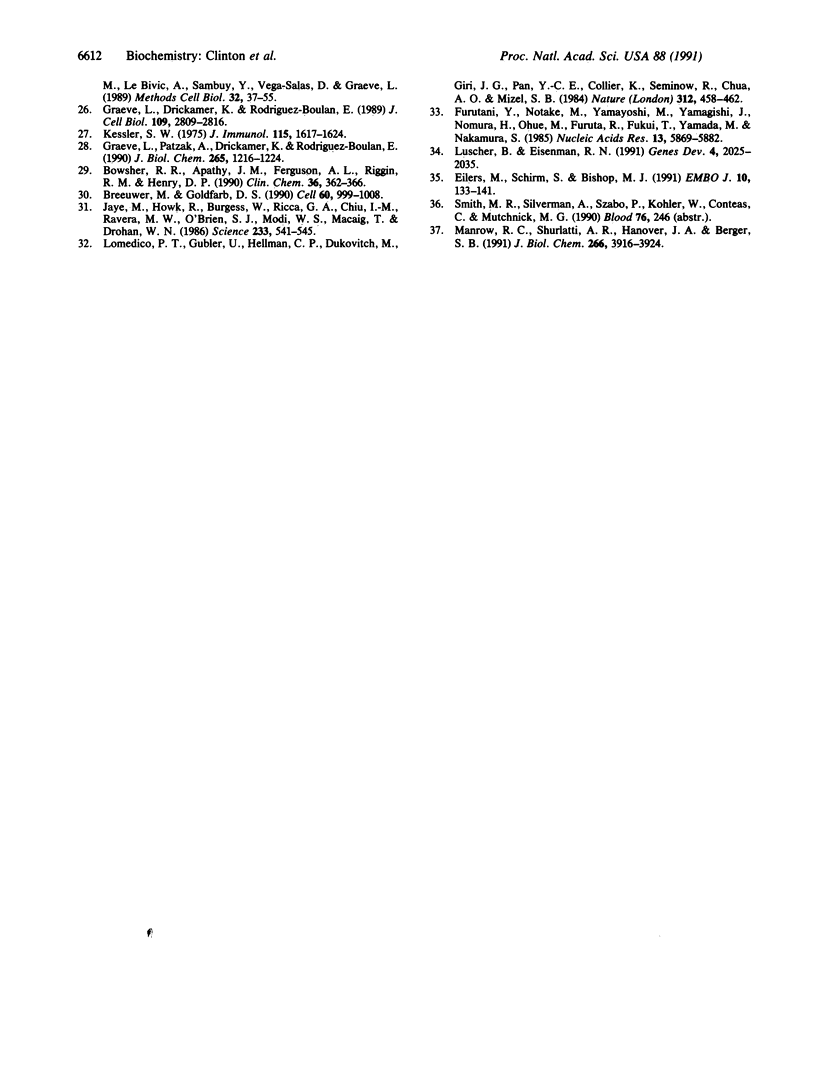
Images in this article
Selected References
These references are in PubMed. This may not be the complete list of references from this article.
- Bowsher R. R., Apathy J. M., Ferguson A. L., Riggin R. M., Henry D. P. Cross-reactivity of monomeric and dimeric biosynthetic human growth hormone in commercial immunoassays. Clin Chem. 1990 Feb;36(2):362–366. [PubMed] [Google Scholar]
- Breeuwer M., Goldfarb D. S. Facilitated nuclear transport of histone H1 and other small nucleophilic proteins. Cell. 1990 Mar 23;60(6):999–1008. doi: 10.1016/0092-8674(90)90348-i. [DOI] [PubMed] [Google Scholar]
- Caldarella J., Goodall G. J., Felix A. M., Heimer E. P., Salvin S. B., Horecker B. L. Thymosin alpha 11: a peptide related to thymosin alpha 1 isolated from calf thymosin fraction 5. Proc Natl Acad Sci U S A. 1983 Dec;80(24):7424–7427. doi: 10.1073/pnas.80.24.7424. [DOI] [PMC free article] [PubMed] [Google Scholar]
- Clinton M., Frangou-Lazaridis M., Panneerselvam C., Horecker B. L. Prothymosin alpha and parathymosin: mRNA and polypeptide levels in rodent tissues. Arch Biochem Biophys. 1989 Feb 15;269(1):256–263. doi: 10.1016/0003-9861(89)90107-0. [DOI] [PubMed] [Google Scholar]
- Clinton M., Frangou-Lazaridis M., Panneerselvam C., Horecker B. L. The sequence of human parathymosin deduced from a cloned human kidney cDNA. Biochem Biophys Res Commun. 1989 Feb 15;158(3):855–862. doi: 10.1016/0006-291x(89)92801-5. [DOI] [PubMed] [Google Scholar]
- Conteas C. N., Mutchnick M. G., Palmer K. C., Weller F. E., Luk G. D., Naylor P. H., Erdos M. R., Goldstein A. L., Panneerselvam C., Horecker B. L. Cellular levels of thymosin immunoreactive peptides are linked to proliferative events: evidence for a nuclear site of action. Proc Natl Acad Sci U S A. 1990 May;87(9):3269–3273. doi: 10.1073/pnas.87.9.3269. [DOI] [PMC free article] [PubMed] [Google Scholar]
- Eilers M., Schirm S., Bishop J. M. The MYC protein activates transcription of the alpha-prothymosin gene. EMBO J. 1991 Jan;10(1):133–141. doi: 10.1002/j.1460-2075.1991.tb07929.x. [DOI] [PMC free article] [PubMed] [Google Scholar]
- Eschenfeldt W. H., Berger S. L. The human prothymosin alpha gene is polymorphic and induced upon growth stimulation: evidence using a cloned cDNA. Proc Natl Acad Sci U S A. 1986 Dec;83(24):9403–9407. doi: 10.1073/pnas.83.24.9403. [DOI] [PMC free article] [PubMed] [Google Scholar]
- Eschenfeldt W. H., Manrow R. E., Krug M. S., Berger S. L. Isolation and partial sequencing of the human prothymosin alpha gene family. Evidence against export of the gene products. J Biol Chem. 1989 May 5;264(13):7546–7555. [PubMed] [Google Scholar]
- Frangou-Lazaridis M., Clinton M., Goodall G. J., Horecker B. L. Prothymosin alpha and parathymosin: amino acid sequences deduced from the cloned rat spleen cDNAs. Arch Biochem Biophys. 1988 Jun;263(2):305–310. doi: 10.1016/0003-9861(88)90640-6. [DOI] [PubMed] [Google Scholar]
- Furutani Y., Notake M., Yamayoshi M., Yamagishi J., Nomura H., Ohue M., Furuta R., Fukui T., Yamada M., Nakamura S. Cloning and characterization of the cDNAs for human and rabbit interleukin-1 precursor. Nucleic Acids Res. 1985 Aug 26;13(16):5869–5882. doi: 10.1093/nar/13.16.5869. [DOI] [PMC free article] [PubMed] [Google Scholar]
- Goldstein A. L., Low T. L., McAdoo M., McClure J., Thurman G. B., Rossio J., Lai C. Y., Chang D., Wang S. S., Harvey C. Thymosin alpha1: isolation and sequence analysis of an immunologically active thymic polypeptide. Proc Natl Acad Sci U S A. 1977 Feb;74(2):725–729. doi: 10.1073/pnas.74.2.725. [DOI] [PMC free article] [PubMed] [Google Scholar]
- Goodall G. J., Dominguez F., Horecker B. L. Molecular cloning of cDNA for human prothymosin alpha. Proc Natl Acad Sci U S A. 1986 Dec;83(23):8926–8928. doi: 10.1073/pnas.83.23.8926. [DOI] [PMC free article] [PubMed] [Google Scholar]
- Graeve L., Drickamer K., Rodriguez-Boulan E. Polarized endocytosis by Madin-Darby canine kidney cells transfected with functional chicken liver glycoprotein receptor. J Cell Biol. 1989 Dec;109(6 Pt 1):2809–2816. doi: 10.1083/jcb.109.6.2809. [DOI] [PMC free article] [PubMed] [Google Scholar]
- Graeve L., Patzak A., Drickamer K., Rodriguez-Boulan E. Polarized expression of functional rat liver asialoglycoprotein receptor in transfected Madin-Darby canine kidney cells. J Biol Chem. 1990 Jan 15;265(2):1216–1224. [PubMed] [Google Scholar]
- Gómez-Márquez J., Segade F., Dosil M., Pichel J. G., Bustelo X. R., Freire M. The expression of prothymosin alpha gene in T lymphocytes and leukemic lymphoid cells is tied to lymphocyte proliferation. J Biol Chem. 1989 May 25;264(15):8451–8454. [PubMed] [Google Scholar]
- Gómez-Márquez J., Segade F. Prothymosin alpha is a nuclear protein. FEBS Lett. 1988 Jan 4;226(2):217–219. doi: 10.1016/0014-5793(88)81425-x. [DOI] [PubMed] [Google Scholar]
- Hannappel E., Davoust S., Horecker B. L. Isolation of peptides from calf thymus. Biochem Biophys Res Commun. 1982 Jan 15;104(1):266–271. doi: 10.1016/0006-291x(82)91969-6. [DOI] [PubMed] [Google Scholar]
- Haritos A. A., Goodall G. J., Horecker B. L. Prothymosin alpha: isolation and properties of the major immunoreactive form of thymosin alpha 1 in rat thymus. Proc Natl Acad Sci U S A. 1984 Feb;81(4):1008–1011. doi: 10.1073/pnas.81.4.1008. [DOI] [PMC free article] [PubMed] [Google Scholar]
- Haritos A. A., Salvin S. B., Blacher R., Stein S., Horecker B. L. Parathymosin alpha: a peptide from rat tissues with structural homology to prothymosin alpha. Proc Natl Acad Sci U S A. 1985 Feb;82(4):1050–1053. doi: 10.1073/pnas.82.4.1050. [DOI] [PMC free article] [PubMed] [Google Scholar]
- Haritos A. A., Tsolas O., Horecker B. L. Distribution of prothymosin alpha in rat tissues. Proc Natl Acad Sci U S A. 1984 Mar;81(5):1391–1393. doi: 10.1073/pnas.81.5.1391. [DOI] [PMC free article] [PubMed] [Google Scholar]
- Jaye M., Howk R., Burgess W., Ricca G. A., Chiu I. M., Ravera M. W., O'Brien S. J., Modi W. S., Maciag T., Drohan W. N. Human endothelial cell growth factor: cloning, nucleotide sequence, and chromosome localization. Science. 1986 Aug 1;233(4763):541–545. doi: 10.1126/science.3523756. [DOI] [PubMed] [Google Scholar]
- Kessler S. W. Rapid isolation of antigens from cells with a staphylococcal protein A-antibody adsorbent: parameters of the interaction of antibody-antigen complexes with protein A. J Immunol. 1975 Dec;115(6):1617–1624. [PubMed] [Google Scholar]
- Kirschmeier P. T., Housey G. M., Johnson M. D., Perkins A. S., Weinstein I. B. Construction and characterization of a retroviral vector demonstrating efficient expression of cloned cDNA sequences. DNA. 1988 Apr;7(3):219–225. doi: 10.1089/dna.1988.7.219. [DOI] [PubMed] [Google Scholar]
- Lomedico P. T., Gubler U., Hellmann C. P., Dukovich M., Giri J. G., Pan Y. C., Collier K., Semionow R., Chua A. O., Mizel S. B. Cloning and expression of murine interleukin-1 cDNA in Escherichia coli. 1984 Nov 29-Dec 5Nature. 312(5993):458–462. doi: 10.1038/312458a0. [DOI] [PubMed] [Google Scholar]
- Low T. L., Goldstein A. L. Thymosin fraction 5 and 5A. Methods Enzymol. 1985;116:219–233. doi: 10.1016/s0076-6879(85)16016-7. [DOI] [PubMed] [Google Scholar]
- Lüscher B., Eisenman R. N. New light on Myc and Myb. Part I. Myc. Genes Dev. 1990 Dec;4(12A):2025–2035. doi: 10.1101/gad.4.12a.2025. [DOI] [PubMed] [Google Scholar]
- Makarova T., Grebenshikov N., Egorov C., Vartapetian A., Bogdanov A. Prothymosin alpha is an evolutionary conserved protein covalently linked to a small RNA. FEBS Lett. 1989 Nov 6;257(2):247–250. doi: 10.1016/0014-5793(89)81544-3. [DOI] [PubMed] [Google Scholar]
- Manrow R. E., Sburlati A. R., Hanover J. A., Berger S. L. Nuclear targeting of prothymosin alpha. J Biol Chem. 1991 Feb 25;266(6):3916–3924. [PubMed] [Google Scholar]
- Palvimo J., Linnala-Kankkunen A. Identification of a low-Mr acidic nuclear protein as prothymosin alpha. FEBS Lett. 1990 Dec 17;277(1-2):257–260. doi: 10.1016/0014-5793(90)80860-l. [DOI] [PubMed] [Google Scholar]
- Trompeter H. I., Brand I. A., Söling H. D. The primary sequence of the PFK-1 inactivating zinc-binding protein as deduced from cDNA sequencing. Identity of the zinc-binding protein with rat parathymosin. FEBS Lett. 1989 Aug 14;253(1-2):63–66. doi: 10.1016/0014-5793(89)80930-5. [DOI] [PubMed] [Google Scholar]
- Tsitsiloni O. E., Yialouris P. P., Sekeri-Pataryas K., Haritos A. A. Prothymosin alpha is not a nuclear polypeptide. Experientia. 1989 Apr 15;45(4):332–334. doi: 10.1007/BF01957467. [DOI] [PubMed] [Google Scholar]
- Watts J. D., Cary P. D., Crane-Robinson C. Prothymosin alpha is a nuclear protein. FEBS Lett. 1989 Mar 13;245(1-2):17–20. doi: 10.1016/0014-5793(89)80182-6. [DOI] [PubMed] [Google Scholar]
- Watts J. D., Cary P. D., Sautiere P., Crane-Robinson C. Thymosins: both nuclear and cytoplasmic proteins. Eur J Biochem. 1990 Sep 24;192(3):643–651. doi: 10.1111/j.1432-1033.1990.tb19271.x. [DOI] [PubMed] [Google Scholar]



